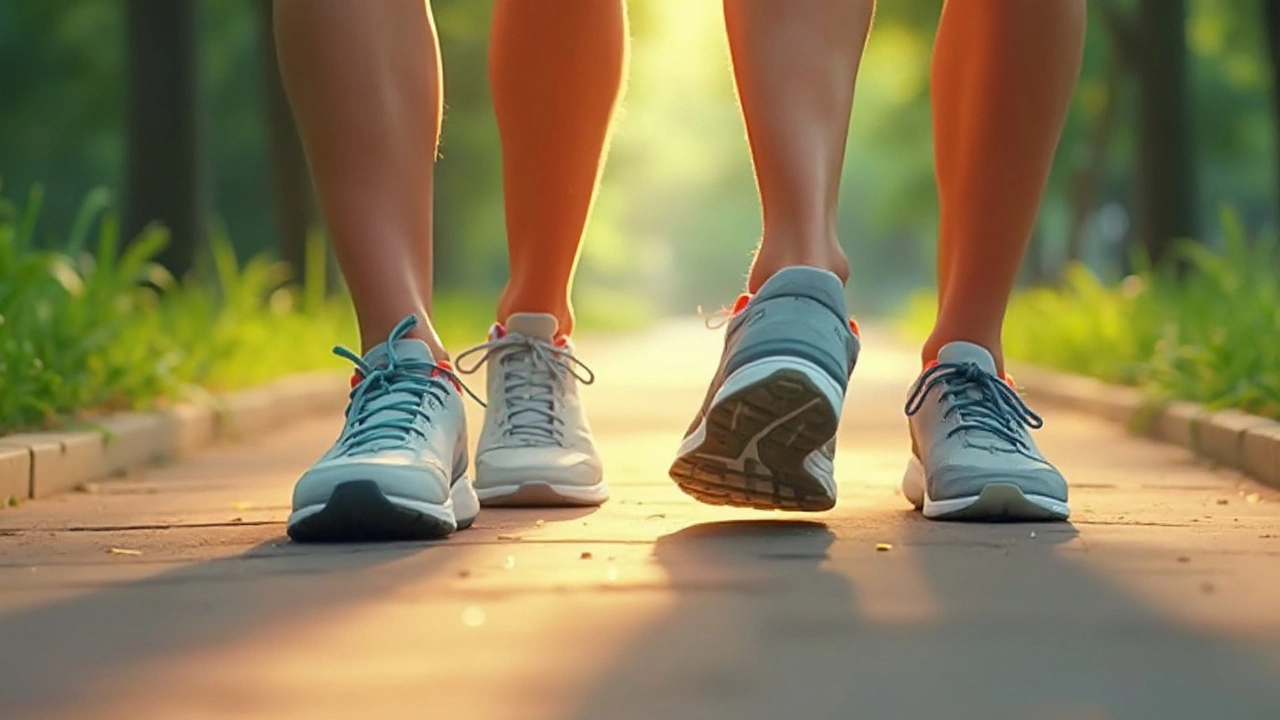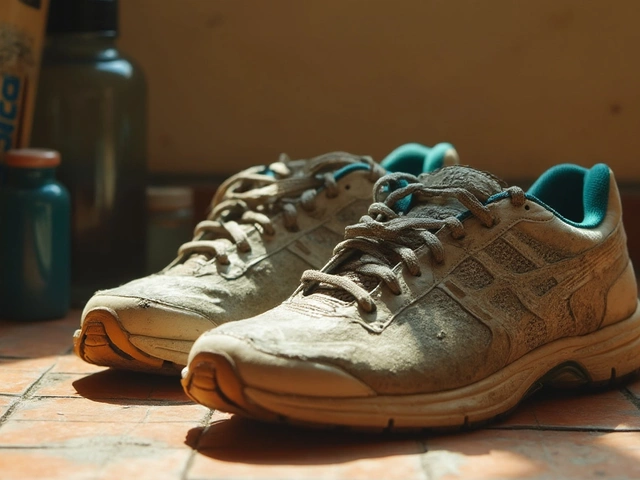Ever stared at your running shoes before heading out for a walk and wondered if you’re doing it wrong? You’re not the only one. A lot of people use their running shoes for daily strolls, but there’s a bit more to it than just grabbing what’s by the door.
Running shoes look a lot like walking shoes at first. The thing is, they’re actually built for different jobs. Running shoes usually have more cushion, a little extra bounce, and sometimes a heel that’s higher off the ground. Why? Running slams your feet harder and needs that shock absorption. But if you’re just walking to the store or cruising around the block, is all that tech really helping you … or is it just overkill?
If your feet get tired or sore after even a short walk, your shoes might be to blame. Mixing up running and walking shoes by accident—or on purpose—can make a big difference in how you feel and how your body moves. But before you chuck your runners into the closet for good, it’s worth figuring out which features actually matter for your style and speed.
- Running Shoes vs. Walking Shoes: What’s Different?
- Comfort and Support: Walking in Running Shoes
- When Running Shoes Make Sense for Walking
- Mistakes People Make Using Running Shoes for Walking
- Tips for Getting the Best Out of Your Shoes
Running Shoes vs. Walking Shoes: What’s Different?
You’d think shoes are shoes, right? Turns out, running shoes and walking shoes are built for different needs. The way your foot hits the ground while running isn’t the same as when you’re walking. Runners land heavy on their heels or midfoot and push off fast, while walking is all about rolling smoothly from heel to toe. Shoe makers keep this in mind, so the design details really matter.
Here’s how these two types of shoes stack up side by side:
| Feature | Running Shoes | Walking Shoes |
|---|---|---|
| Cushioning | Extra cushioning, especially in the heel and forefoot | Moderate cushioning, even throughout |
| Weight | Lighter for less drag | Often a bit heavier |
| Flexibility | More flex in the forefoot for toe-off | Flex in midsole, less in forefoot |
| Heel Height | Usually higher to protect against impact | Lower heel, closer to the ground |
| Tread Pattern | Grippier, for traction while running | Simpler, just enough for steady walks |
Now, let’s focus on why running shoes often get chosen for walking: people love the extra cushioning. It feels like walking on a soft mat, and that’s pretty nice if you’re on your feet all day. But all that extra bounce isn’t always needed for slower, steady walking. Plus, the thick soles and curvy shape in running shoes can sometimes throw off your stride when you walk; it’s a subtle thing, but over time it can actually change how your joints line up and move.
Another cool fact: studies have shown walkers put around 1.5 times their body weight on each step, while runners face forces of more than 3 times their weight. That’s why running shoes need to “overbuild” cushion and shock absorption. But when you’re just walking, that bulk can make your feet tire faster instead of less.
There’s also the shape. A lot of running shoes have a pointed toe box to help with speed, while walking shoes give a bit more room up front, stopping your toes from feeling cramped after a long stroll. This is one of those small things you may not notice at first, until you spend hours in the wrong shoe and end up with sore feet or even blisters.
If you only remember one thing, it’s that wearing the right shoe for the right activity can make walking or running way more comfortable and can even help you avoid injuries. Matching your shoes to the job pays off every single day.
Comfort and Support: Walking in Running Shoes
Walking in running shoes is something lots of people do without a second thought. Most running shoes are made to cushion the heel and push you forward, since running means you land harder and roll off your toes faster. That extra cushion can make walks feel like you’re gliding, especially if you’re pounding the pavement for miles.
But here’s the catch: walking puts pressure on different parts of the foot compared to running. When you walk, your foot rolls from heel to toe more slowly. Some running shoes have thick, chunky heels and lots of flex at the front end—great for runners, but sometimes awkward for walkers. You might feel the shoes “rocking” you forward too fast, which gets uncomfortable if you’re on hard surfaces for long periods.
Support is another thing to think about. Running shoes usually hug your feet tighter to stop extra movement, which is good for running but can feel stiff on easy walks. They often have more arch support, which doesn’t always match up with your needs for regular walking. If you already have flat feet or higher arches, too much or too little support in the wrong place can end up hurting after a while.
One known fact: the American Academy of Podiatric Sports Medicine actually says that walking shoes are built with less heel height and more flexibility in the soles. This helps your foot bend naturally as you walk. So, if you’re logging a lot of daily steps, your foot could end up happier in shoes made specifically for walking.
Still, running shoes can be great if you’re doing short or fast walks, or need extra cushion. You just have to watch out for signs your feet aren’t loving it—like sore toes, pinched heels, or weird aches that start popping up. If comfort drops after a few blocks, your shoe choice is probably the reason.

When Running Shoes Make Sense for Walking
So when does it actually make sense to use running shoes for walking? For most people, it happens more often than you'd think. If you already have a pair hanging around, there are times they can be an easy win for your feet.
Walking on hard surfaces—like city streets, concrete, or asphalt—calls for extra cushion. Running shoes are designed with thicker midsoles and shock-absorbing foam, which means they can take the sting out of hard pavement. If your day involves long stretches of standing or brisk, high-paced walking, they can feel pretty nice compared to flat, unsupportive footwear.
People with foot pain or old injuries sometimes notice they're more comfortable in running shoes because of better padding under the heel and forefoot. Brands put a lot of work into making their midsoles lighter, softer, and more responsive year after year. If you’ve got joint pain or issues like plantar fasciitis, studies out of Boston University and the Mayo Clinic suggest the extra cushion in running shoes can actually help reduce strain.
Folks who walk fast (think power walkers or those keeping up a fitness pace above 5 km/h) benefit from a running shoe’s built-in toe spring—a slightly upward curve at the front—making it easier to roll through each step without dragging your foot.
- If you stand or walk on hard surfaces most of the day
- If you’re dealing with heel or arch pain
- If you prefer a lightweight, well-cushioned feel
- If you power walk or do fast-paced daily walking
- If you just don’t want to buy separate pairs for walking and running
Check out these numbers based on major running shoe models as of 2024:
| Model | Weight (Men’s Size 9) | Cushion (mm) | Good for Walking? |
|---|---|---|---|
| Nike Pegasus 41 | 275g | 33/23 | Yes, great for daily wear |
| Asics Gel Nimbus 26 | 305g | 42/34 | Yes, especially for comfort |
| Brooks Ghost 16 | 282g | 36/24 | Yes, neutral fit suits lots of walkers |
| Hoka Bondi 8 | 308g | 43/39 | Yes, for max cushioning folks |
Bottom line: if you like how your running shoes feel, and you're not having issues, there’s no rule saying you can’t grab them for your everyday walk.
Mistakes People Make Using Running Shoes for Walking
Plenty of folks grab their running shoes for daily walks without thinking twice, but there are some mistakes that can mess with your comfort and even put you at risk for injuries. Not all kicks are created equal, even if they look similar.
The biggest problem? Wearing out your shoes too fast. Running shoes are built for, well, running. When you put miles on them walking every day, you burn through the cushioning and grip much quicker than you’d expect. You might look down after a few months and realize the tread’s gone and the shoes feel flat. That’s not good for your joints.
Here are some other common mistakes people make:
- Picking the wrong fit. Running shoes are often designed snug to prevent slippage while running, but walking needs more wiggle room for toes. If your shoes feel tight or your toes are rubbing, you might set yourself up for blisters and black toenails.
- Ignoring foot support. Not every running shoe supports your arch in the way you need for regular walking. Too much arch or not enough can both lead to pain—especially if you have flat feet or high arches.
- Using heavy, high-cushion shoes for short or slow walks. Super-cushy trainers feel comfy at first but might actually make walking harder by feeling bulky or awkward over time.
- Skipping socks. It’s tempting to slip on your running shoes without socks if you’re just heading out for a short walk, but friction builds up quickly and can leave your feet battered.
Tread wear and cushioning loss get overlooked a lot too. Studies show running shoes usually last 300–500 miles, but regular walking can cut that down by up to 30% if you use the same pair all day, every day. That means you’re looking at replacing your shoes every six months or so if you’re active.
| Mistake | Consequence |
|---|---|
| Using old, worn shoes | Less shock absorption, more joint pain |
| Wrong size/fit | Blisters, black toenails, discomfort |
| No arch support | Foot pain, plantar fasciitis risk |
| Going sockless | Blisters, odor, fungal issues |
| Overusing running shoes for walking | Frequent shoe replacements |
So, if you’re using running shoes for walking, watch for these common mistakes. Your feet will thank you, and you’ll get more life out of your running shoes if you treat them right.

Tips for Getting the Best Out of Your Shoes
Wearing your running shoes for walking isn’t a crime, but you want to make sure you’re not just wasting good gear—or your own comfort. A few habits can boost how much you get out of your shoes, and might even make them last longer.
- Rotate pairs. Don’t use the same running shoes for both workouts and daily walks if you can help it. Shoes break down faster if you never give them a day off, so switch for a backup now and then.
- Watch the mileage. Even the cushiest running shoes usually cap out at about 500 miles before they start feeling flat. Walking in dead shoes is rough on your body. If you’re a stats fan, apps like Strava or Garmin can keep track for you.
- Clean them up. Dirt and grime eats away at the fabric and the glue holding the soles together. Wipe your shoes with a damp cloth and let them air dry. Never toss them into a blazing dryer—it can melt the foam.
- Lace them right. Loose laces cause blisters and heel slip. Try the "runner’s loop" technique for a snug but comfy fit. Feels weird at first, but it locks you in much better for walks.
- Check your socks. Cotton socks trap sweat and rub your skin raw over time. Go for synthetic or merino wool—the same kind runners use. Less stink and more comfort.
Here’s a quick chart to help you stay on top of shoe care and replacement:
| Tip | Why It Matters | Frequency |
|---|---|---|
| Rotate shoes | Slows wear and helps foam recover | Every other day |
| Track mileage | Prevents pain from worn-out support | Every use (via app/manual log) |
| Clean shoes | Extends shoe life, keeps odor down | Monthly or as needed |
| Replace insoles | Improves comfort after cushion breaks down | Every 300 miles or if shoes smell |
| Check fit and lacing | Reduces blisters and foot pain | Before every walk |
Little tweaks like these can stretch the lifespan of your running shoes—and keep your daily walks way more enjoyable. Happy feet are hard to beat.





